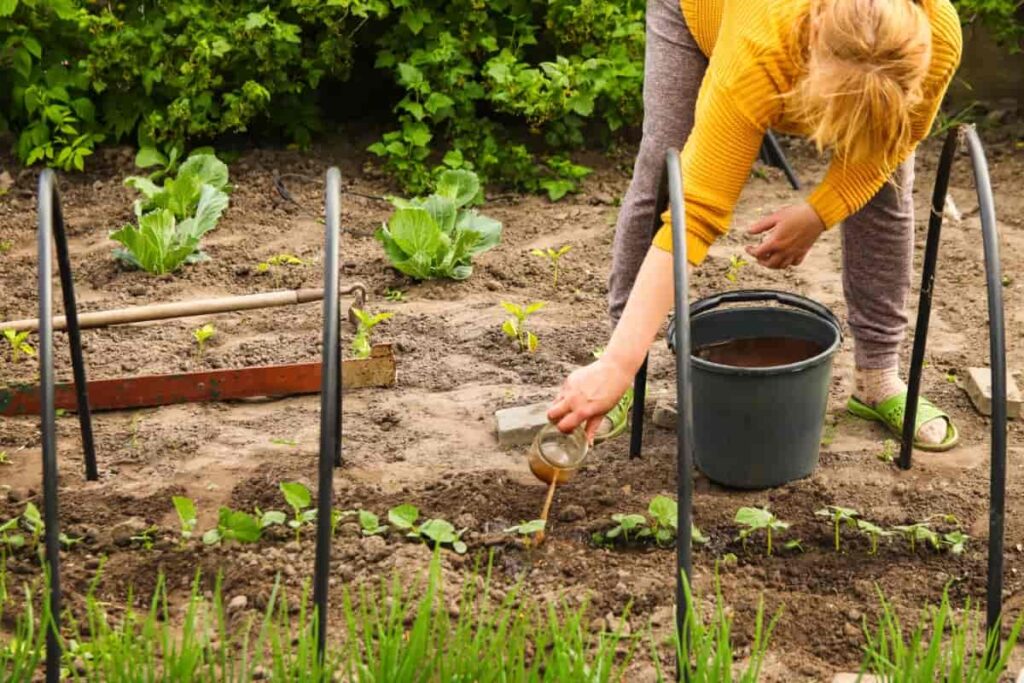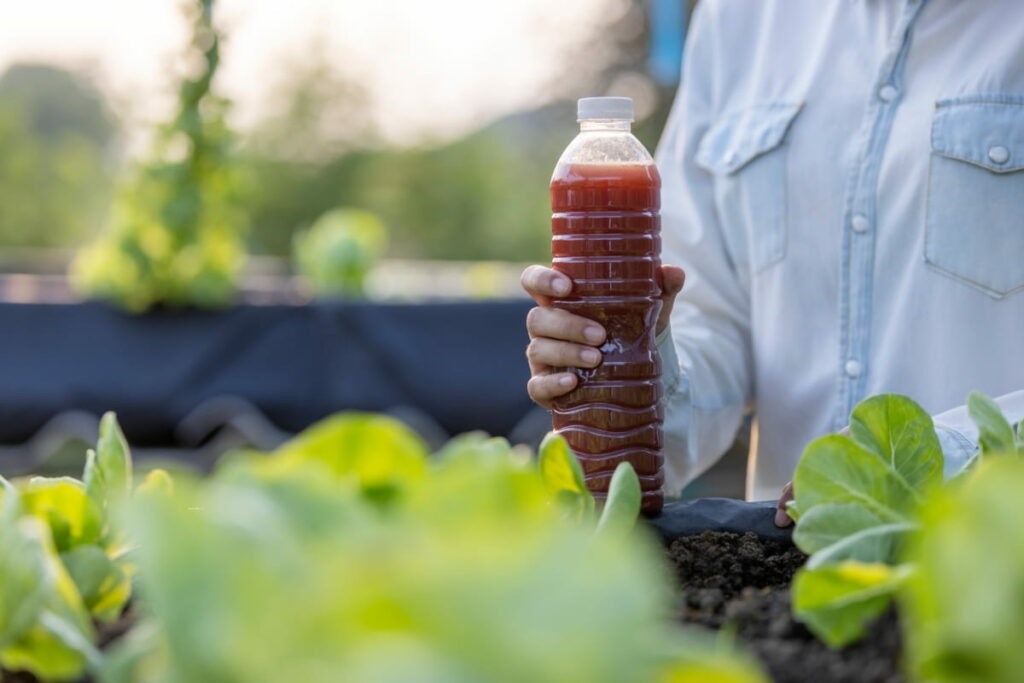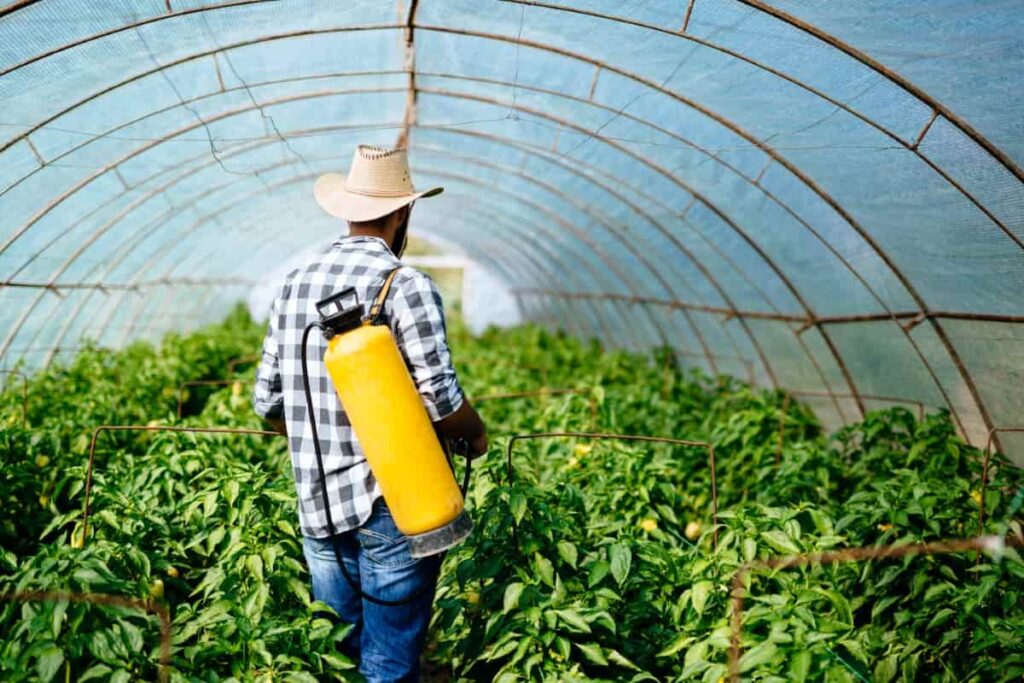Jeevamrutham organic fertilizer is a cow dung and urine fertilizer that is widely used in sustainable and organic farming practices. It is a concoction made from various organic ingredients that help improve soil health, promote beneficial microbial activity, and enhance plant growth. Jeevamrutham is known for its ability to replenish soil nutrients and foster a healthy ecosystem for plants to thrive.
Benefits of Jeevamrutham for Organic Farming
- Natural soil enhancer Jeevamrutham: Jeevamrutham enriches the soil with nutrients, organic matter, and beneficial microorganisms, thus enhancing soil fertility and structure.
- Improving Plant Growth With Jeevamrutham: The nutrients and microorganisms present in Jeevamrutham promote robust plant growth, leading to healthier and more vigorous crops.
- Pest and Disease Resistance: Regular application of Jeevamrutham strengthens plants’ natural defenses, making them more resistant to pests and diseases.
- Environmental Sustainability: Jeevamrutham is made from natural, renewable ingredients, making it an environmentally friendly alternative to synthetic fertilizers and chemical additives.

Homemade Jeevamrutham Recipe
Jeevamrutham Ingredients
- Cow Dung / The Foundation: Cow dung is rich in organic matter and beneficial microorganisms essential for soil health and plant growth. It serves as the primary ingredient in Jeevamrutham, providing valuable nutrients like nitrogen, phosphorus, and potassium.
- Cow Urine: / Liquid Gold: Cow urine is a potent source of nitrogen, potassium, and other essential nutrients. It also contains beneficial microorganisms that aid in soil conditioning and plant nutrition.
- Jaggery / A Sweet Touch: Jaggery acts as a natural sweetener and energy source for the microorganisms present in Jeevamrutham. It helps in the fermentation process and enhances microbial activity in the soil.
- Pulses Flour / Nutrient Rich: Pulses flour, such as chickpea flour or lentil flour, provides additional nutrients and proteins to Jeevamrutham. It enriches the mixture with essential amino acids and micronutrients beneficial for plant growth.
- Soil / The Carrier of Microorganisms: Soil acts as a carrier for the beneficial microorganisms present in Jeevamrutham. It provides a medium for microbial proliferation and ensures their effective distribution in the soil.
Tools and Equipment Required
- Large Container for Mixing: A container with a capacity of at least 20 liters is recommended to accommodate all ingredients and allow for thorough mixing.
- Measuring Tools: Utilize measuring cups or scales for precise measurement of ingredients to maintain the proper ratio and consistency.
- Stirring Stick or Spatula: A sturdy stirring stick or spatula facilitates the effective mixing of ingredients, ensuring uniform distribution and consistency in the mixture.
Preparing the Base Mixture: How To Make Jeevamrutham
- Mixing Cow Dung and Urine: Combine cow dung and urine in a ratio of 1:3 to 1:5, stirring continuously to ensure thorough incorporation and uniformity in the mixture.
- Adding Jaggery and Pulses Flour: Incorporate jaggery (approximately 10% of the total volume) and pulses flour (around 5-10% of the total volume) to enrich the mixture with essential nutrients.
- Incorporating Soil for Microbial Action: Mix soil thoroughly into the base mixture to serve as a carrier for beneficial microorganisms and initiate the fermentation process, enhancing microbial activity.
In case you missed it: 10 Homemade Fertilizers for Money Plant: Natural Ways to Nourish Potted Golden Pothos

The Jeevamrutham Fermentation Process
Setting the Mixture for Fermentation
- Transfer the prepared base mixture to a covered container to initiate the fermentation process.
- Ensure the container is airtight to maintain proper conditions for fermentation.
Ideal Conditions for Effective Fermentation
- Place the fermentation container in a warm, shaded area with adequate ventilation.
- Maintain a temperature range of 20-30°C for optimal microbial activity.
- Avoid sunlight exposure and extreme temperatures, as they can hinder fermentation.
Duration of Fermentation
- Allow the mixture to ferment for approximately 3-5 days, depending on environmental conditions and the desired level of fermentation.
- During fermentation, stir the mixture occasionally to promote uniform microbial activity and prevent any potential odors.
Jeevamrutham Application Methods
Determining the Right Time for Application
- Apply Jeevamrutham during the active growth phase of plants, typically in the early morning or late afternoon.
- This fertilizer application should be avoided during extreme weather conditions like rain or intense sunlight.
Application Methods for Different Plant Types
- For vegetables and annual crops: Dilute Jeevamrutham with water in a 1:10 ratio and apply as a soil drench or else foliar spray every 10-15 days.
- For fruit trees and perennials: Apply undiluted Jeevamrutham around the base of the plants or incorporate it into the soil every 4-6 weeks.
- For seedlings and young plants: Dilute Jeevamrutham further (1:20 ratio) and apply as a gentle foliar spray to avoid overwhelming delicate roots.
Frequency of Jeevamrutham Application
- Apply Jeevamrutham regularly throughout the growing season to maintain soil fertility and promote plant growth.
- The frequency may vary depending on plant growth stage, soil condition, and environmental factors. Still, a general guideline is to apply every 10-15 days for vegetables and annual crops and every 4-6 weeks for fruit trees and perennials. Adjust the frequency based on observed plant response and soil nutrient levels.
Benefits of Jeevamrutham to Soil and Plants
Improving Soil Structure
- Jeevamrutham enriches the soil with organic matter, enhancing its structure and texture.
- It improves soil aeration and water retention, promoting better root development and nutrient uptake.
Enhancing Microbial Activity
- Jeevamrutham contains beneficial microorganisms that enhance soil microbial diversity and activity.
- They release nutrients and enzymes that are beneficial for plant growth and soil health by breaking down organic matter.
Boosting Plant Growth and Health
- The nutrients and growth-promoting substances in Jeevamrutham stimulate plant growth and development.
- It enhances plant vigor, resistance to pests and diseases, and overall health, resulting in higher yields and better-quality produce.
Troubleshooting Common Issues
Dealing with Odor
- If the Jeevamrutham mixture emits a strong odor, it may indicate insufficient aeration or excessive moisture.
- To mitigate odor, ensure proper ventilation during fermentation and avoid sealing the container tightly. Stir the mixture regularly to promote airflow and reduce odor.
Adjusting Mixture Consistency
- If the mixture is too thick or too thin, it may affect its effectiveness and application.
- To adjust consistency, add water to thin out a thick mixture or add more organic matter (such as cow dung or jaggery) to thicken a thin mixture. Aim for a consistency similar to a thick soup or yogurt.
Dealing with Over-Fermentation
- Over-fermentation can occur if the mixture is left for too long or in unfavorable conditions, leading to a sour smell and nutrient loss.
- To address over-fermentation, dilute the mixture with water to reduce its potency and acidity. Use the diluted solution for application, and adjust the fermentation duration and conditions for future batches to prevent over-fermentation.
In case you missed it: Chilli Pepper Growth Fertilizer: Maximize Chilli Pepper Yield with Fertilization Schedule

Sustainable Practices in Preparing Jeevamrutham
Sourcing Ingredients Locally
- Obtain cow dung, urine, jaggery, and pulses flour from local farmers or suppliers to reduce carbon emissions associated with transportation.
- Supporting local producers also fosters community resilience and reduces dependence on distant sources.
Minimizing Waste
- Use organic kitchen waste, such as vegetable peels and leftover food, as additional ingredients in Jeevamrutham to minimize waste generation.
- Compost any unused or spoiled Jeevamrutham mixture to return nutrients to the soil and complete the nutrient cycle.
Reusing Containers and Tools
- Utilize reusable containers and tools for mixing, storing, and applying Jeevamrutham to minimize plastic waste.
- Clean and sanitize containers and tools after each use to prolong their lifespan and reduce the need for replacements.
In case you missed it: Best Fertilizer for Rhubarb: Rhubarb Fertilization 101

Conclusion
Jeevamrutham preparation at home offers a sustainable and effective approach to enriching soil fertility and promoting plant growth. By sourcing local ingredients, minimizing waste, and reusing containers and tools, this homemade Jeevamrutham recipe embodies principles of environmental stewardship. Embracing these practices not only nurtures healthier plants but also fosters a deeper connection to the natural cycles that sustain our gardens and ecosystems.
- Crops Grown in Summer Season: Best Choices for Summer Gardening
- Organic Pest Control for Tomato Farming
- How to Maximize Sheep Farming Profit
- Broccoli Varieties: Choosing the Right Cultivars for Your Farm
- How to Raise Pigs in Your Own Backyard: A Comprehensive Guide
- Budget Friendly Sheep Shed Ideas: Cheap and Low-Cost Tips
- How Much Do Cattle Farmers Make: Revenue Streams in Cattle Farming
- Management Pests and Diseases in Your Cotton Field
- Sheep Farming Business Plan for Beginners
